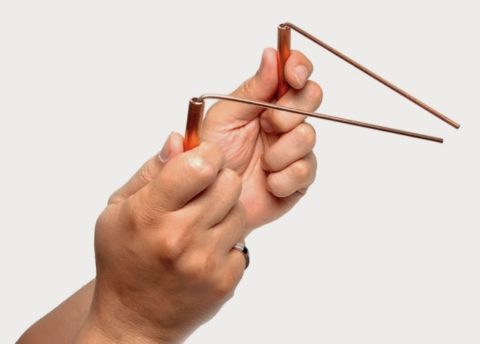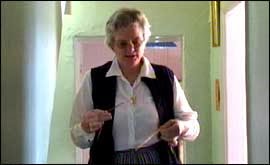Boulder, CO – In an effort to improve patient care by reducing the number of needle sticks needed to obtain IV access or to draw blood for testing, an increasing number of nurses have turned to an ancient method used for finding sources of underground water.
“Finding a suitable vein for drawing blood or placing an IV can be challenging, particularly in older or obese patients,” explained Hortense Samuelson, a nurse at the Mountain View Manor skilled nursing facility in Boulder and recipient of a practitioner certification in Medical Dowsing. “Since I began using medical dowsing to locate good veins, I can hardly remember any instances where I haven’t been successful in the first few tries.”

A set of medical grade phlebotomy dowsing rods, manufactured by Globodyne Industries.
Dowsing, known historically as “water witching”, is a 600-year-old method of divination traditionally used to find groundwater. But over the years, dowsing practitioners have branched out into other areas. These days, dowsers can be found not only on farms finding new sources of fresh water, but also working with petrochemical companies on the hunt for new oil deposits and prospectors searching for hidden gold.
The addition of locating hard to find veins to dowsing’s repertoire was truly a no-brainer, and it originated in Boulder, right down the street from the Mountain View Manor skilled nursing facility. Since 2008, the Institute of Medical Dowsing (IMD) has offered certification to interested nurses and other healthcare professionals. The IMD is actively pursuing national accreditation of their Medical Dowsing Certification (MDC) with the National Commission for Certifying Agencies (NCCA) as well as credentialing from the Institute of Credentialing Excellence (ICE) for their Medical Dowsing Certified Practitioner (MDCP) program. They have successfully obtained approval from the National Acronym Approval Association (NAAA).
For those interested in a more advanced understanding of medical dowsing, the MDCP program consists of a rigorous weekend session designed to teach the knowledge of dowsing as it applies to a variety of medical areas, not simply phlebotomy. For instance, a certified medical dowser can also help locate hidden areas of inflammation or cancer. They can also be called upon to find lost articles of clothing or a patient’s car keys upon discharge from a facility.

Nurse Samuelson, shown here using dowsing rods to locate a missing patient.
How medical dowsing, and dowsing in general, works remains somewhat of a mystery. Proponents believe that their specially designed tools, often in the form of two L-shaped rods, allow for the detection of subtle energies or vibrations. One school of thought, in regards to medical dowsing, is that the metallic rods are drawn together when over a source rich in iron such as human blood.
A hit occurs when the two rods move over one another. Or they may point in opposite directions, forming a straight line and perhaps indicating a particularly long segment of blood vessel close to the surface. Sometimes the rods are prevented from moving by nearby interference, such as when there is a skeptical family member in the room or when the clinic had been built on iron-rich soil. But for a highly trained medical dowsing practitioner, the rods don’t always need to move in order to successfully locate an area of clinical concern or interest.
“I once worked on a man who, several years later, was found to have metastatic liver cancer right under where I remember getting a strong feeling as my rods passed over,” Samuelson revealed. “You don’t forget something like that. That’s why I trust my training and the scientific foundation it was built on.”
Critics have questioned the validity of dowsing, citing the failure to successfully find water under controlled testing conditions and an overall lack of scientific plausibility. But this type of negativity doesn’t concern Nurse Samuelson and other proud practitioners of medical dowsing. “I know it works because I’ve seen the results myself. And patients love it. At the end of the day, isn’t that what truly matters?”
Uncrossing the rods
I realize that medical dowsing sounds ridiculous, largely because it is ridiculous. This does not, as I’m sure readers of SBM know all too well, mean that there aren’t plenty of people out there who believe in it and support incorporating it into conventional medical practice. This is true despite the many controlled attempts to replicated dowsing success that have failed to show it works better than mere chance, and a highly plausible explanation for what dowsing practitioners experience known as the ideomotor phenomenon.
What inspired me to post this today, however, was a March 2022 article on dowsing in the field of forensics that I recently stumbled upon. The article features a highly respected program in the field of crime scene investigation:
Dowsing for the dead is not exactly endorsed by scientists or forensic experts. But it is a highlight for some students attending the National Forensic Academy, a 10-week training program sponsored by the University of Tennessee. Since the academy’s inaugural class 20 years ago, school administrators say, more than 1,200 crime-scene investigators from agencies in 49 US states and five foreign countries have attended the program, which currently costs students $12,000.
The featured forensic dowsing expert is a walking textbook in pseudoscience belief systems, even comparing himself to Galileo:
Cutting-edge scientists have always faced skepticism and even persecution, he says. “Galileo’s a great example. Remember what the church did to him when he said Earth was not the center of the universe?”
Though dowsing in the field of forensics is hardly mainstream, my jaw hit the floor when I read this:
In particular, some experts are distressed that a Vass trainee recently got witching results admitted as evidence in a Georgia murder trial. This could set a legal precedent and allow witching-based evidence to be used in other cases, says Chris Fabricant, a lead attorney for the Innocence Project, which works to exonerate wrongfully convicted prisoners. “The search for the truth is never advanced through junk science,” he says.
Sadly, I was able to confirm this and even found video of the testimony involving dowsing. It starts at 15:45 and involves a description of dowsing as well as a demonstration, in a court of law during a murder trial. The man even makes an excuse ahead of time in case his demonstration fails, claiming that a nearby cemetery could interfere with the rods. This is a completely uncontrolled test with a box of bones in clear view, so there was zero chance that the rods weren’t going to behave as desired by the so-called expert.

